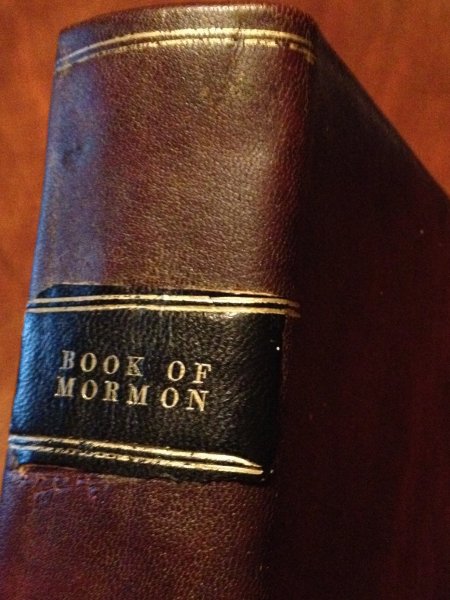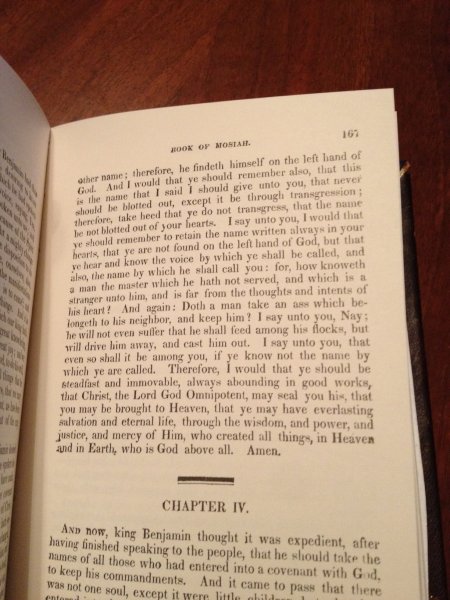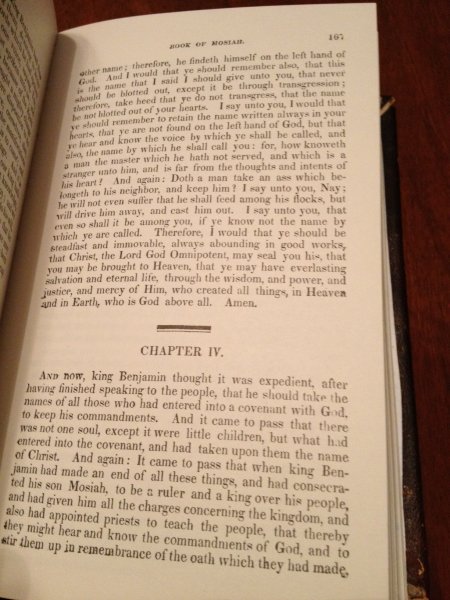 It’s late, the kids (and my parents) are asleep, and my wife and I are sitting at the same table downstairs playing on our laptops.
It’s late, the kids (and my parents) are asleep, and my wife and I are sitting at the same table downstairs playing on our laptops.
We’re at the end of a vacation that has taken us from the Lower East Side in New York City (we rented an apartment there for a week), to Ithaca, Palmyra, and then finally to Niagara. In Palmyra, we spent a day and a half exploring church history sites.
I’m in the Grandin Printing Shop on E. Main in Palmyra. An affable guide is doing his best to impose some structure on our visit, but I’m not cooperating. I’ve left the group and I’m wondering around on my own. I discover a 1st edition of the Book of Mormon in a glass case near the back of the building. I stare at it for a few minutes. I wander over to a counter that might have been there nearly 200 years ago when Joseph Smith walked in looking for someone to print the first 5000 copies of the Book of Mormon. On the counter I discover a leather-bound replica of the 1st edition of the Book of Mormon. It’s printed by Herald Publishing House (an entity I suspect is associated with the Community of Christ). I want a copy. When I ask the guide about it, he suggests I check next door at the Latter-Day Harvest book store.
I walk over to the bookstore and discover a stack of replicas, but the binding on these editions is modern (like a standard hardback book). I’m helped by a friendly young women who tells me that her husband hand binds 1st editions of the Book of Mormon using the same materials and tools used in 1830, and that there might be one copy left in the Palmyra Inn gift shop a couple miles down the road. By now my wife and kids are at Nima’s Pizzeria down the street. I call the Palmyra Inn while eating a surprisingly good (and very hot) slice of pizza. I tell them I’ll be there in 20 minutes, and they promise to hold the last handbound copy of the Book of Mormon for me until I get there.
It’s a beatiful book. The binding is stiff, and it smells like ink, glue and leather. Joseph Smith, Junior, is listed as the author and proprietor on the title page, there is a preface explaining the loss of the first 116 translated pages, and the testomonies of the three witnesses and the eight witnesses are in the back of the book. The text is arranged in standard paragraphs (instead of two columns of verses), and there are no chapter headings.
I spend the next three or four hours holding the book, feeling the texture of the leather with the palms of my hands, testing the binding, reading random excerpts from different pages. . . I can’t put it down.
“This is my religion,” I think to myself as I hold the book in my hands. “This I can understand.”
I was at the Whitmer farm. I sat in the same place where Joseph Smith sat with his head in a hat and dictated the Book of Mormon. I can image how they were dressed, what the fields looked like as the sun came up in the morning, and I can almost see Oliver Cowdery, a former school teacher, sitting quietly in the corner of the small cabin carefully writing down Joseph’s words with a quill pen. I’ll never know what was going on in Joseph’s head during this process. It is as opaque to me as what went on in Handel’s head when he composed the Messiah, or in Rainman’s head when he was in a casino counting cards, but that’s not the point.
I can image Joseph going into Grandin’s and negotiating the printing contract. I’m not surprised that Grandin had to think about it. It was an unusual (and unusually large) order for a small town press.
I look at the replica in my hands and I think about the printing equipment at Grandin’s. I think about the process of printing 5000 octavos of the Book of Mormon. I imagine young workers spending day after day binding the copies. It took seven months to complete the order. I now know more or less how they did it, thanks to another cheerful guide on the 2nd floor of Grandin’s who walked us through the process a few hours earlier. Someone pointed out a couple sections of the interior wall that were part of the original building on our way out.
From the bottom of a hat, through Joseph’s mouth, to the tip of Oliver Cowdery’s quill pen, then through the tedious process of typsetting, printing, and then binding. . . I have finally traced the ripples in the pond back to their source.
Thumbing through a first edition of a Book of Mormon is like talking to Joseph Smith about his experience in the grove an hour after he returned to the house, instead of reading a 4th or 5th draft written for a public audience years after the experience in the context of nearly two hundred years of cultural mythologizing. I remind myself that the first vision wasn’t part of the vocabulary of early saints. It wasn’t used as a misionary tool. That came later.
Holding this book, I can see past the happy stories populated by behives, seagulls, and a God that always rewards hard work. Where did we get our fierce attachment to familiar narratives and walks into the sunset?
I can see that deception, hypocrisy, Fanny Alger, secret marriages, propositions to young girls, proposals to married women, jealousies, grudges, treachery, betrayal–all of it–are part of story. Good and bad are yin and yang. Remove the bad and it drains the color from the good. It turns the complexity of life into cardboard props. It makes it impossible to understand why so many of Joseph Smith’s inner circle turned against him, why he was tarred and feathered, and why he was martyred.
A first edition of the Book of Mormon is the ground, the sky, and the faint trace of a brick wall built in the 1820s that runs through the grove of trees behind the Smith property. The current edition is the reconstructed home, built a few years ago where we think the original home stood.
In short, what I hold in my hands–and what I can’t seem to put down–is what our religion looked like before it was Disney-fied. I smell the spine of the book. I riffle the pages. There’s no going back to the fairy tale.
[Last Post: 34 Charity by Force?]
******
;






” It’s printed by Harold Publishing House (an entity I suspect is associated with the Community of Christ).”
Actually is Herald House of the Community of Christ.
http://www.heraldhouse.org/cart/edit.asp?p=122575
“What our religion looked like before it was Disney-fied.”
Great line. Thanks for a very interesting post.
I will never think of Disney in the same way. Or the BoM, for that matter. I wonder if you would be willing to allow curious friends to “riffle its pages” too?
Loved this.
I do feel a little like Dorothy at the end of the Wizard of Oz. Oh… the truth is so different from the black and white – which is both good and bad. Yet our whole Mormon truth sure is colorful, isn’t it? I’ve always been a sucker for a really good story.
Good work, Brent. I think I know exactly what you mean about sometimes having an almost visceral connection to our past.
We sing from our hymnal that “millions shall know brother Joseph again”, and I think that many of those will be lifelong LDS who finally get around to making the effort to learn and understand the whole, messy, difficult, glorious story.
“messy, difficult, glorious”…that describes my feelings well. Thanks, Mark.
I love this. Thanks for sharing these feelings. I served my mission in Palmyra and can relate to a lot of what you explain so well here. The Grandin Building (and Whitmer Farm) will hold a special place in my heart forever, even though a lot has changed for me since the days when I’d show people around. I feel like so much of what I hear and read about the early days of the church is either mega-whitewashed or very cynical. Thanks for the reminder about that in between feeling of acknowledging complexity and error while still feeling some reverence for what started it all. And man, I could really go for some Nima’s…
Terrific post! Interestingly, the church has done a lot to strip away the false narrative in Palmyra since we used to go there when I was very little. A lot of these sites were stuck in a later time period, having continually been in use until they were restored. The Smith Family home is now completely different than it was when I was a teen. The plaster and wallpaper was chipped out to reveal the rustic whitewashed boards underneath. Finally we are getting somewhere! However, they’ve taken the grove in another direction with neatly groomed trails. I remember walking through the dense trees in my scooter skort at age 5 half wishing half fearing that God the Father would pop out from behind a tree for a friendly chat. Now I half expect to be overtaken by joggers as I walk through the grove.